
Mahipati (1715 - 1790) [1] [2] was an 18th century Marathi language hagiographer who wrote biographies of prominent Hindu Vaishnava sants who had lived between the 13th and the 17th centuries in Maharashtra and other regions of India. [3] [4]

Mahipati (1715 - 1790) [1] [2] was an 18th century Marathi language hagiographer who wrote biographies of prominent Hindu Vaishnava sants who had lived between the 13th and the 17th centuries in Maharashtra and other regions of India. [3] [4]
Mahipati was born in a Marathi Deshastha Rigvedi Brahmin family of Shakala Shakha and Vasishta gotra [5] to Dadopant Kamble who was the hereditary Kulkarni (record keeper) of Taharabad in present day Ahmednagar district of Maharashtra. Dadopant and his wife were devotees of Vithoba of Pandharpur. [6] [7] [8] After his father's death, he inherited the job of Kulkarni for Taharabad. He also worked for a local Mughal landlord. After falling out with his landlord, Mahipati devoted the rest of his life to performing Kirtans on lives of saints, collecting information on these saints and writing their hagiographies. [4]
During his life, Mahipati played down his abilities, his hagiographies of the Varkari saints are considered to be the most authoritative. [3] Mahipati claimed Varkari sant Tukaram as the inspiration for his writings. [9] Although in early part of his literary career he relied on works by Nabha Dass and Uddhava Ciddhan for his biographies, he soon realized shortcomings in their accounts of the saints and started collecting information himself. Mahipati, at times, during his life wrote multiple biographies of the same saint. He included any new information he obtained about the saint in his newer biographies. He also believed that the lives of the revered saints can not be grasped in a single sweep. Callewaert et al , therefore call the later biographies as the "revised editions of the old books. [4] Mahipati wrote his biographies in the Ovi metre. [7] Christian Lee Novetzke considers Mahipati's work to be a kind of transcribed kirtan. Indeed during his life mahipati, per Novetzke, was known as a kirtankar (Kirtan performer) rather than a writer. [10]
| Work | Chapters | Number of Ovis | Year of Composition |
|---|---|---|---|
| Bhaktavijaya | 57 | 9916 | 1762 |
| Kathasaramrita (1765) | 12 | 7200 | 1765 |
| Santalilaamrit (1757) | 35 | 5259 | 1757 |
| Bhaktalilaamrit (1774) | 51 | 10794 | 1774 |
| Santavijayaश् | 26 (incomplete) | 4628 | 1796 |
| Pandharimahatmya | 12 | - | - |
| Anantvratkatha | - | 186 | - |
| dattatryeya janma | - | 112 | - |
| tulasi Mahatmya | 5 | 763 | - |
| Ganeshpuran | 4 (Incomplete) | 304 | - |
| Pandurang stotra | - | 308 | - |
| Muktabharan vrat | - | 101 | - |
| Rishpanchami vrat | - | 142 | - |
| Apradh nivedan stotra | - | 101 | - |
| Sphut abhang and stotre | - | - | - |
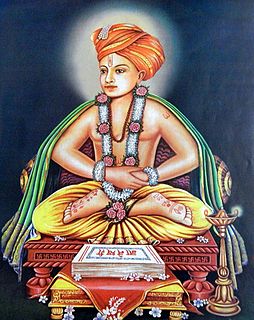
Sant Dnyaneshwar, also referred to as Jnaneshwar, Jnanadeva, Dnyandev or Mauli or Dnyaneshwar Vitthal Kulkarni (1275–1296), was a 13th-century Indian Marathi saint, poet, philosopher and yogi of the Nath Vaishnava tradition. In his short life of 21 years, he authored Dnyaneshwari and Amrutanubhav. These are the oldest surviving literary works in the Marathi language, under the patronage of the Yadava dynasty of Devagiri, and these are considered to be milestones in Marathi literature. Sant Dnyaneshwar's ideas reflect the non-dualistic Advaita Vedanta philosophy and an emphasis on Yoga and oneness of Vishnu and Shiva. His legacy inspired saint-poets such as Eknath and Tukaram, and he is one of the founders of the Varkari (Vithoba-Krishna) Bhakti movement tradition of Hinduism in Maharashtra. Saint Dnyaneshwar attained Sanjeevan samadhi at Alandi in 1296.
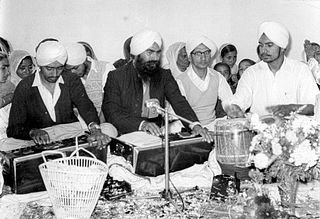
Kirtan is a Sanskrit word that means "narrating, reciting, telling, describing" of an idea or story, specifically in Indian religions. It also refers to a genre of religious performance arts, connoting a musical form of narration or shared recitation, particularly of spiritual or religious ideas, native to the Indian subcontinent.

Sant Tukaram Maharaj was a 17th-century Marathi poet, Hindu sant (saint) and a great devotee of Lord Shri Vitthal, popularly known as Tuka, Tukobaraya, Tukoba in Maharashtra. He was a Sant of Varkari sampradaya in Maharashtra, India. He was part of the egalitarian, personalized Varkari devotionalism tradition. Sant Tukaram Maharaj is best known for his devotional poetry called Abhanga and community-oriented worship with spiritual songs known as kirtans.
Marathi literature is the body of literature of Marathi, an Indo-Aryan language spoken mainly in the Indian state of Maharashtra and written in the Devanagari and Modi script.

Namdev, also transliterated as Nam Dayv, Namdeo, Namadeva, was an Indian poet and saint from Narsi, Hingoli, Maharashtra, India within the Varkari tradition of Hinduism. He lived as a devotee of Lord Vitthal (Krishna) of Pandharpur.

Warkari is a sampradaya within the bhakti spiritual tradition of Hinduism, geographically associated with the Indian state of Maharashtra. Warkaris worship Vitthal, the presiding deity of Pandharpur, regarded as a form of Krishna. Saints and gurus of the bhakti movement associated with the Warkaris include Dnyaneshwar, Namdev, Chokhamela, Eknath, and Tukaram, Gadge Maharaj all of whom are accorded the title of Sant.
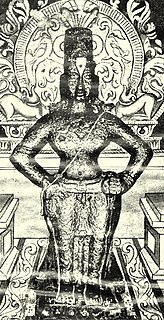
Vithoba, also known as Vi(t)thal(a) and Panduranga, is a Hindu deity predominantly worshipped in the Indian state of Maharashtra and Karnataka. He is generally considered as a manifestation of the god Vishnu or his avatar, Krishna. Vithoba is often depicted as a dark young boy, standing arms akimbo on a brick, sometimes accompanied by his consort Rakhumai.

Pundalik or Pundarik is a central figure in the legends of the Hindu God Vithoba, generally considered a Vaishnava deity identified with the deities Vishnu and Krishna. He is credited to have brought Vithoba to Pandharpur, where Vithoba's central shrine stands today. Pundalik is also perceived to be the historical founder of the Varkari sect, which is centered on the worship of Lord Vithoba.
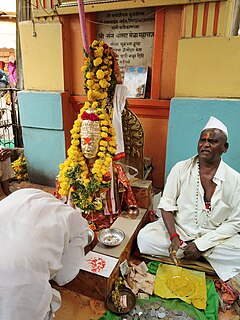
Chokhamela was a saint in Maharashtra, India in the 14th century. He belonged to the Mahar caste, present day, it's considered one of the untouchable castes in India. He was born at Mehuna Raja, a village in Deulgaon Raja Taluka of Buldhana district. He lived at Mangalvedha in Maharashtra. He wrote many Abhangas. One of his famous Abhangas is 'Abir Gulal Udhlit Rang". He was one of the first low-cast poets in India. Chokhamela lived with his wife Soyarabai and son Karmamela in Mangalvedha. Chokhamela's task was to guard and work in farms of upper caste people.

Abhanga is a form of devotional poetry sung in praise of the Hindu god Vitthal, also known as Vithoba. The word "abhang" comes from a for "non-" and bhang for "ending" or "interrupting", in other words, a flawless, continuous process, in this case referring to a poem. By contrast, the devotional songs known as Bhajans focus on the inward journey. Abhangs are more exuberant expressions of the communitarian experience. Abhanga is considered a form of the ovi. Abhangs are sung during pilgrimage to the temples of Pandharpur, by the devotees.
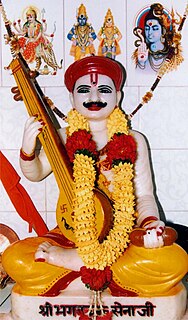
Sena Nhavi, also known as Sain Sena, and Sena, is a Hindu saint-poet (sant-kavi) of the Varkari sect dedicated to the god Vithoba.
Visoba Khechara, spelled also as Visoba Khechar or Visoba Khecar, was the yogi-guru of the Varkari poet-saint Namdev (c.1270-1350) of Maharashtra, India. Visoba was a disciple of the Varkari poet-saint Jñāneśvar. He had linkages with the Varkari tradition as well as the Nath tradition of Maharashtra. Though a staunch Shaiva, Visoba has composed verses in praise of the god Vithoba, the patron deity of the Varkari faith. He has also composed a metaphysical treatise called the Shatsthala.
Kanhopatra was a 15th-century Marathi saint-poet, venerated by the Varkari sect of Hinduism.
Bir Kuar or Birkuar, also known as Birnath, is a Hindu cattle-god worshipped by Yadavs of western Bihar in India. He is considered to be a form of god Krishna and was born in Krishnaut clan. He is worshipped in form of wooden posts that depict him standing arms-akimbo. Bir Kuar is honoured as the protector of cattle and the god who infuses fertility in cattle.
Maha Bhakta vijaya is a Marathi text by Mahipati around 1762 that extols the deeds of the saint-poets of the Varkari sect of Hinduism. It has been translated into various languages in India and is widely read. It forms an important part of the prayer for devotees of Vithoba at Pandharpur. An English translation was published under the provisions of the will of Justin E. Abbott in 1933.
Sant Gora Kumbhar was a Hindu sant associated with the Bhakti movement and the Varkari sect of Maharashtra. He was a potter by trade and devotee of Vithal.

Sant Eknath, commonly known as Sant (saint) Eknath was an Indian Hindu saint, philosopher and poet. He was a devotee of the Hindu deity Krishna and is a major figure of the Warkari tradition. Eknath is often viewed as a spiritual successor to the prominent Marathi saints Dnyaneshwar and Namdev.
Bhanudasa (1448–1513), was a Hindu sant who brought back the sacred image of the god Vithoba back from Vijayanagara to Pandharpur, its original location. He was Eknath’s great grandfather. As a boy he worshipped the Sun but later came to worship Vithoba. He is the subject of two chapters in the Bhaktavijaya. His Samadhi situated in solkhambi mandap of Vitthal temple at Pandharpur.

Narahari Sonar or Narhari Sonar or Narharidas(संत नरहरी महाराज) is an 11th-century Hindu poet-saint of the Varkari sect and goldsmith (sonar) from Maharashtra, India. His hagiography speaks about his transition from a staunch Shaiva to a Vithoba-worshipping Varkari after a miracle that makes him realize that Vithoba and Shiva are one and the same.
Damaji, also known as Damaji Pant, Sant Damaji and Bhakta Damaji, was a 15th-century Marathi saint (sant) or bhakta ("devotee"), venerated by the Varkari sect of Hinduism. He was the Kamavisdar of Mangalvedha under the Bahamani king of Bidar. He is described as a devotee of the god Vithoba - the patron deity of the Varkari sect. He distributed grain from the royal granaries to the people in famine. Vithoba is said to have come as an outcaste with a bag of gold to pay for the grain and rescue Damaji. The famine of 1460 is known as Damaji Pant's famine in the Deccan region in honour of Damaji's generosity in the famine.
Notes
Citations